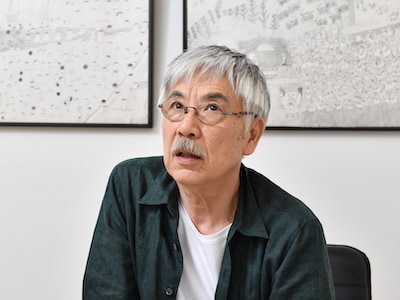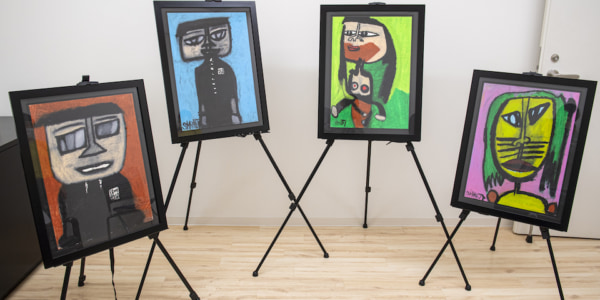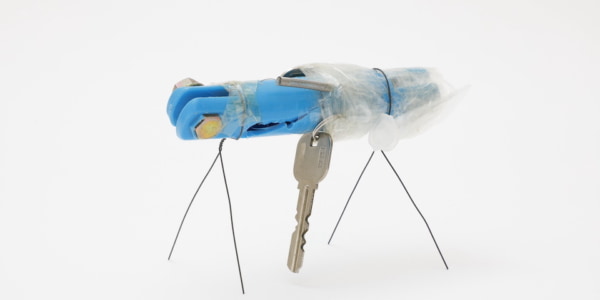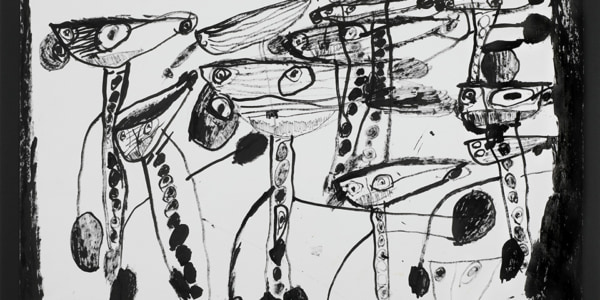Co-starring
KAMAE Kazumi(1966-)
Kamae lives in Shiga Prefecture. She has been a member of〈Atelier Yamanami〉since 1985. Often finding it difficult to share her thoughts and feelings with others, she uses her works as a way to communicate, creating three-dimensional figures of a certain someone she wants to notice her—all of her pieces are modeled on the man she loves. She starts by choosing a theme and creating the work’s underlying form, then, in many of her works, painstakingly embeds pieces of clay like tiny grains of rice into every inch of the figure’s surface. Her large works can require around two months or more to complete, countless grains of clay completely covering an entire work and transforming it into a variety of forms.
![[Photograph (Works)]](https://www.diversity-in-the-arts.jp/admin/wp-content/uploads/2021/10/issei1.jpg)
From left to right: “Face” / 606×238×227mm / Porcelain clay, natural wood-ash glaze / 2007 /Collection of The Nippon Foundation
“Face” / 233×225×212mm / Porcelain clay, natural wood-ash glaze / 2007 /Collection of The Nippon Foundation
“Face” / 483×213×200mm / Porcelain clay, natural wood-ash glaze / 2007 /Collection of The Nippon Foundation
“Face” / 538×310×248mm / Porcelain clay, natural wood-ash glaze / 2007 /Collection of The Nippon Foundation
We know that there were ancient civilizations around Central and Southern America: the Aztecs, the Inca, and others. These works are clay figures discovered when an archaeologist was excavating a site in this region. In terms of time period, they were likely made when the country was being attacked and laid waste by invaders come from another continent—an attempt by an artisan of the period to record this tragedy in physical form. Because they didn’t have a written language, there is no document of what happened back then. All we can do is interpret these statues.
The archaeologist thought that this one, the first to be unearthed, was an indigenous person who had lived their whole life in this land.
![[Photograph (Works)]](https://www.diversity-in-the-arts.jp/admin/wp-content/uploads/2021/10/8bdc770ef848de644eb067b63d223358.jpg)
“Face” / 606×238×227mm / Porcelain clay, natural wood-ash glaze / 2007 /Collection of The Nippon Foundation
He theorized that this guy, the next to be found, was an attacking invader, clad in armor.
![[Photograph (Works)]](https://www.diversity-in-the-arts.jp/admin/wp-content/uploads/2021/10/0e31b3552729a045ce8eeee5e4a689d3.jpg)
“Face” / 483×213×200mm / Porcelain clay, natural wood-ash glaze / 2007 /Collection of The Nippon Foundation
So what, then, was this little one?
![[Photograph (Works)]](https://www.diversity-in-the-arts.jp/admin/wp-content/uploads/2021/10/8caac9c1818e67613ad7aa4eff95bbc4.jpg)
“Face” / 233×225×212mm / Porcelain clay, natural wood-ash glaze / 2007 /Collection of The Nippon Foundation
As he thought about it, the archaeologist changed his theory. “I’ve got the wrong idea,” he thought.
“The first statue I unearthed is a person, but this little fellow is an infectious disease.” That’s right, it was the Coronavirus.
But then, what did that make this second one to be unearthed?
![[Photograph (Works)]](https://www.diversity-in-the-arts.jp/admin/wp-content/uploads/2021/10/458fb341d3ff239f877e06e4cbd60913.jpg)
“Face” / 483×213×200mm / Porcelain clay, natural wood-ash glaze / 2007 /Collection of The Nippon Foundation
It was a mask. It turned out that the people of however many thousand years ago had lived through a similar period to our own. In that case, what we’d like to know is how they went on to bring the Coronavirus under control. Yet no matter how hard he looked, the archaeologist couldn’t find any kind of answer. Nevertheless, he received an enormous number of inquiries about what had happened, so he brought out the first statue once more.
![[Photograph (Works)]](https://www.diversity-in-the-arts.jp/admin/wp-content/uploads/2021/10/8bdc770ef848de644eb067b63d223358.jpg)
“Face” / 606×238×227mm / Porcelain clay, natural wood-ash glaze / 2007 /Collection of The Nippon Foundation
That’s when he concocted his theory that, although the epidemic had spread and there had been a period of mask-wearing, things had been able to go back to normal.
But the truth was, he had discovered another, more powerful infectious disease.
![[Photograph (Works)]](https://www.diversity-in-the-arts.jp/admin/wp-content/uploads/2021/10/2b215d3b8c7fc543004345e10e7ce6a7.jpg)
“Face” / 538×310×248mm / Porcelain clay, natural wood-ash glaze / 2007 /Collection of The Nippon Foundation
That’s right, a variant. But he covered it up. Because he knew it would cause a stir. Then he started to feel conflicted. “Did I do the right thing?”
“I deliberately put out this theory to give people hope. It may have been wrong for me to do that as a scientist, but I was pointing toward a beacon of hope for humanity.”
The indigenous people were attacked by invaders and laid waste by disease, but their bloodlines lived on, mixed with those of the invaders. There is a way of thinking that would say: so what, biologically speaking, if they no longer exist as a nation, so long as they survive within the human race? Yet some would ask whether simply staying alive is all that matters; whether this can really be what it means to be human.
With the 2020 Olympics, too, people’s standpoints were different, between the people saying it would be better not to hold the event and those saying it had to go on. Because they were approaching the issue from completely different perspectives, there was no way they could meet in the middle. This kind of conflict and division were playing out within the archaeologist, too.
* *
As he was considering these issues, another theory occurred to him.
![[Photograph (Works)]](https://www.diversity-in-the-arts.jp/admin/wp-content/uploads/2021/10/issei2.jpg)
“Face” / 606×238×227mm / Porcelain clay, natural wood-ash glaze / 2007 /Collection of The Nippon Foundation
“Face” / 483×213×200mm / Porcelain clay, natural wood-ash glaze / 2007 /Collection of The Nippon Foundation
It could well be that the pathogen had actually been in the country all along, before being brought over by the invaders, and that the indigenous person, the first statue (left in the above photo), had been praying, when the mask, the second statue to be unearthed (right in the above photo), had appeared, and they had together reasoned that masks were the important thing, better than praying.
![[Photograph (Works)]](https://www.diversity-in-the-arts.jp/admin/wp-content/uploads/2021/10/issei3.jpg)
“Face” / 606×238×227mm / Porcelain clay, natural wood-ash glaze / 2007 /Collection of The Nippon Foundation
“Face” / 233×225×212mm / Porcelain clay, natural wood-ash glaze / 2007 /Collection of The Nippon Foundation
“Face” / 538×310×248mm / Porcelain clay, natural wood-ash glaze / 2007 /Collection of The Nippon Foundation
And that’s when it came to him. He noticed that the statue of the indigenous person that had been first unearthed (left-most in the above photo) and the Coronavirus statue (centered in the photo) had certain similarities. Looking closely, he saw that the patterns on their bodies closely resembled one another and that their hands and feet displayed the same distinguishing features. Looking even more closely, he saw that the variant (right-most in the photo) had those same features. In other words, he saw that humanity and the infectious disease, the pathogen, had become connected. They had assimilated and kept going. They had lived with each other. They had become variant-humans.
![[Photograph (Works)]](https://www.diversity-in-the-arts.jp/admin/wp-content/uploads/2021/10/issei4.jpg)
From left to right: “Face” / 606×238×227mm / Porcelain clay, natural wood-ash glaze / 2007 /Collection of The Nippon Foundation
“Face” / 233×225×212mm / Porcelain clay, natural wood-ash glaze / 2007 /Collection of The Nippon Foundation
“Face” / 538×310×248mm / Porcelain clay, natural wood-ash glaze / 2007 /Collection of The Nippon Foundation
When the archaeologist looked at the figures this way, a powerful sense of alienation grew between the variant-humans and the mask. The mask had been there to protect people, yet it was now being treated as definitively other, and he started to feel sorry for it. It had no one to keep it company.
From this point of view, the mask statue began to take on the appearance of a rather pitiful face.
![[Photograph (Works)]](https://www.diversity-in-the-arts.jp/admin/wp-content/uploads/2021/10/d5234f2401000ce1e25692b9dc1aa8b8.jpg)
“Face” / 248×213×200mm / Porcelain clay, natural wood-ash glaze / 2007 /Collection of The Nippon Foundation
The figure was sulking, lower lip stuck out. It had no face for him to read an expression on, yet something about it seemed to give an impression of loneliness, even. The archaeologist was feeling more and more empathy with the mask.
And as he did, the statue of the indigenous person that he had thought was offering prayers to drive out disease suddenly seemed to him terribly cruel.
![[Photograph (Works)]](https://www.diversity-in-the-arts.jp/admin/wp-content/uploads/2021/10/cbf3253e08149bf75e21987e03dd5584.jpg)
“Face” / 606×238×227mm / Porcelain clay, natural wood-ash glaze / 2007 /Collection of The Nippon Foundation
Then he hit upon a shocking idea. Could this statue that he had first thought was an indigenous person actually be the invader? Actually the mask was an indigenous person, and the invader had arrived later and ruled over it. Once he had thought of this, the mask statue appeared to him to be obstinately closed off from the rest of the world, like an iron mask in a woolen sweater. By contrast, the other three figures were freely wiggling out feelers. And that’s when it came to him. Could this culture buried in the strata be the rightful forebears of the modern-day humans who invented what we might call the original democracy, tolerant of diversity?
* *
When we change our perspectives like this, the relationships between things shift rapidly. As the archaeologist’s perspective varied, so too did his own way of thinking, and he ended up experiencing a moment in of shifting history.
The archaeologist told himself that by disseminating knowledge of this terrible, plague-borne ordeal of the past in the form of various interpretations, he would be mitigating its diabolical impact. Yet even if he had overstepped the bounds of archeology and argued such extreme theories, the military regimes of the Taliban and Myanmar would surely have shown no interest. Even if he had pleaded his case before Chairman Omi of the Subcommittee on Novel Coronavirus Disease Control in Japan, “what good does telling me about these abstract ideas do?” would have been the likely response.
From what I hear, the archaeologist ultimately ended up declaring his determination to return to the land and tending a vegetable field in Yamanashi Prefecture in a sweater and a hand-made iron mask. There’s a story going around that he’s conducting an experiment in co-existence with the villagers there, with himself in the role of “eccentric.”
It sounds like there are some people who occasionally speak to him. “If you’re getting something out of wearing that thing, maybe I’ll follow your example and try it out,” they say to him. The archaeologist responds:
“There’s nothing good about it. It’s just hot and heavy.” At least for now, the rest of the village has not yet adopted the custom.
Issey Ogata’s Wildly Imaginative Art Appreciation Techniques
As actor, playwright, and director of his one-man show, Issey Ogata brings new worlds to life every day. We asked him for tips on having fun with the power of unfettered imagination.
![[Photograph]作品ごしに思案顔をするイッセー尾形さん](https://www.diversity-in-the-arts.jp/admin/wp-content/uploads/2021/10/A2A0054.jpg)
![[Photograph]作品越しに物語を考えるイッセー尾形さん。](https://www.diversity-in-the-arts.jp/admin/wp-content/uploads/2021/10/A2A0017.jpg)
In both creation and wild imaginings, there is perpetual motion from internal to external, internal to external. Sometimes you arrive at an impasse, but this too is to be cherished
These three-dimensional pieces have a certain humorous aspect, and they have a real presence. I feel sure that Kamae created these pieces with a playful hand. She isn’t coming up with these pieces in her head but creating them with her hands. Perhaps this is why they feel so alive.
The way in which a work has been created also changes the nature of my wild imaginings.
A creator always works on their next piece under the influence of the works they have already created. That kind of continuity is at play. Once you create something, it becomes something external to you—you are then influenced by that external thing—it becomes something internal to you—and this is then externalized by creation. It’s a kind of perpetual motion: internal, external, internal, external.
Perhaps there are times when Kamae, following some kind of impulse in the midst of that motion, covers the entire area around the eyes of one of her three-dimensional figures with lines, only to find that there’s nowhere to go from there. She might even find herself going back to an original pattern because she’s ended up at an impasse.
This sort of thing happens all the time. Creating something because you thought it might turn out well only for it to end up at an impasse is something that has a tendency to happen in both creation and wild imagining.
Yet even if you end up turning back from that cul-de-sac, you are drawn to it. When you block yourself, rather than being blocked by someone else, you’re sort of left with your bottom lip stuck out. Kind of feeling, “I have no way out. I’m at a dead-end,” and this tugs more and more at your heartstrings. Like an image of your future self.
Take the mask statue, which started out with an aloofness that seemed to say “invader,” but in the end actually gained an “idol”-like aspect once the archaeologist started to empathize with it. As I expand my wild imaginings, things depart from how they initially appeared. That was my experience this time, anyway.
![[Photograph]作品を見ながら妄想をするイッセーさん。](https://www.diversity-in-the-arts.jp/admin/wp-content/uploads/2021/10/A2A0222.jpg)
![[Photograph]作品を笑顔で眺めるイッセーさん](https://www.diversity-in-the-arts.jp/admin/wp-content/uploads/2021/10/A2A0030.jpg)
![[Photograph]作品越しに笑顔を見せるイッセーさん](https://www.diversity-in-the-arts.jp/admin/wp-content/uploads/2021/10/A2A0210.jpg)
![[Photograph]笑顔のイッセーさん](https://www.diversity-in-the-arts.jp/admin/wp-content/uploads/2021/10/A2A0051.jpg)
[Corporation] Yanaka no Okatte, NPO Taito Cultural & Historical Society, Ueno-Sakuragi Denchu Hirakushi House and Atelier




![[Photograph]日本家屋の玄関前で、きゅうりをかじる浴衣姿のイッセー尾形さん](https://www.diversity-in-the-arts.jp/admin/wp-content/uploads/2021/10/A2A8928-2_1600pxl.jpg)



